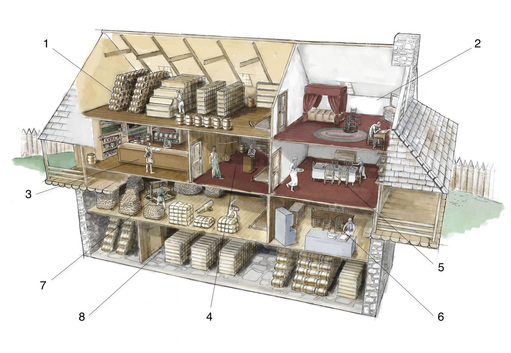The factory, a three-and-one-half story trade house, was where the Osage and other Indian tribes came to trade at Fort Osage. While no goods were manufactured here, the United States kept the old legal term “Factor” to reference the person in charge of the trading. George C. Sibley served as the Fort’s “Factor,” tracking the dollar value of each exchange.
The Osage were promised in their 1808 Treaty, a place for them to buy merchandise in exchange for their peltries and furs. The Factory fulfilled that promise. In order for other Indian tribes to be able to trade at the Fort, they had to get direct permission from the Osage.
There was a wide selection of merchandise available for the Indian Tribes to purchase at Fort Osage. Some of the merchandise Indian Tribes were able to purchase included, tinware, gardening tools, tobacco, muskets, fabric, and an Osage favorite, bells. If there was an item that an Osage wanted to purchase but was not in stock, that item would be made or shipped to the Fort. However, the United States would not sell alcohol to any Indian Tribe at any Factory.

Fort Osage Dec. 25th 1810
Agreeably to the request of Mr. Sibley, we undersigned have surveyed and examined the several buildings, Enclosures, etc. at this place, belonging to the Department of Indian Trade, and have taken into consideration the local situation of those buildings, and the Present Prospects of their public utility. We have their present value as follows.
The Factory House is 53 feet long and 22 feet wide, has two stories of stone under ground and one and a half story of hewed oak logs above ground. Is surrounded (except the north end) by a piazza 6 ½ feet wide, and the whole under a strong roof of white oak joint shingles.
It’s apartments are as follows
In the upper or half story
A store room…35 feet by 20 ½..Proper for storing the unopened goods etc. (1)
The upstairs storeroom held trade goods for barter with the Osage and other Native Americans for their furs. George Sibley could keep an eye on the storeroom, as it was visible from his bedroom.
A bedroom…14 feet by 20 ½ (in the south end) with a fireplace. (2)
This room was George Sibley’s quarters until June 1813, when Fort Osage was temporarily abandoned due to the War of 1812. When the fort reopened in 1815, Sibley, now married, began construction of a house a short distance from the fort. The Sibley house became known as Fountain Cottage, serving as their primary residence until 1827. It is likely that this bedroom served as quarters for the assistant factor after Sibley moved to Fountain Cottage.
In the lower log story
A room…21 ½ feet by 20 ½ with counters, shelves, etc. proper for Trading room. (3)
A room…11 ½ feet by 20 ½ with desk, table, etc. Proper for office (4)
Only Native Americans were allowed to barter in the factory, and they were typically received in the day office. Sibley and his assistant factor kept meticulous records of all transactions. Sibley’s assistant factor in the fall of 1809 was Isaac Rawlings, who later became the factor at Chickasaw Bluffs and helped establish Memphis, Tennessee. He was also the second and fourth mayor of Memphis. Lilburn Boggs, another assistant factor (1820-1822), later became the sixth governor of Missouri (1836-1840).
A room…16 ½ feet by 20 ½ (in the south end) with fireplace, closets, etc. proper for mess or dining room. (5)
Sibley hosted many dinner parties for visiting dignitaries and government officials. He noted in an 1811 letter to his brother, Samuel, that “frequently we are honored with an Osage Chief or war Captain to dine or sup with us.”
In the upper cellar
A room…19 ½ feet by 17 ½ proper for a kitchen (6)
Sibley hired a variety of women to perform domestic chores in the factory. Many of the cooks and laundresses were wives or daughters of garrison soldiers, interpreters, or “sutlers,” people who followed the army and sold provisions and services to the soldiers. For example, Sibley hired the wife of the interpreter, Pierre Lorr, as a cook in 1810, and rented slave labor at various times.
A room…29 ½ feet by 17 ½ under the Trading room) with presses, frames, benches, etc. Proper for packing furs and peltries, etc. (7)
Once hides were acquired in the day office, they were brought downstairs to the packing room. A fur press was used to bundle the furs. The Office of Indian Trade intended soldiers to do the packing work for ten cents a day in extra wages, but poor civilian-military relations occasionally forced Sibley to hire wandering traders and hunters instead. Seasonal labor could be procured in St. Charles or St. Louis.
The lower cellar
Is all in one 48 feet by 16, and is proper for storing peltry, etc. (8)
Furs were stored in the peltry room until they were shipped downriver to St. Louis. Only one factory produced more revenue from furs than Fort Osage. Fort Osage was one of only a couple of factories that operated its own keelboat, The Osage Factor.
This building with its enclosure and improvements, we judge to be worth Four Thousand and Twenty-Five dollars. The Interpreter’s Houses, 2 single houses of hewed oak logs, each 16 feet by 14, both under one roof, we judge to be worth Two Hundred dollars. A small log house lately occupied by the interpreter and his family, we judge to be worth Forty-Five dollars.
(Signed by) David Robinson
E. B. Clemson
John H. Robinson
[i] Records of the Office of Indian Trade, General Services Administration, Washington D.C.